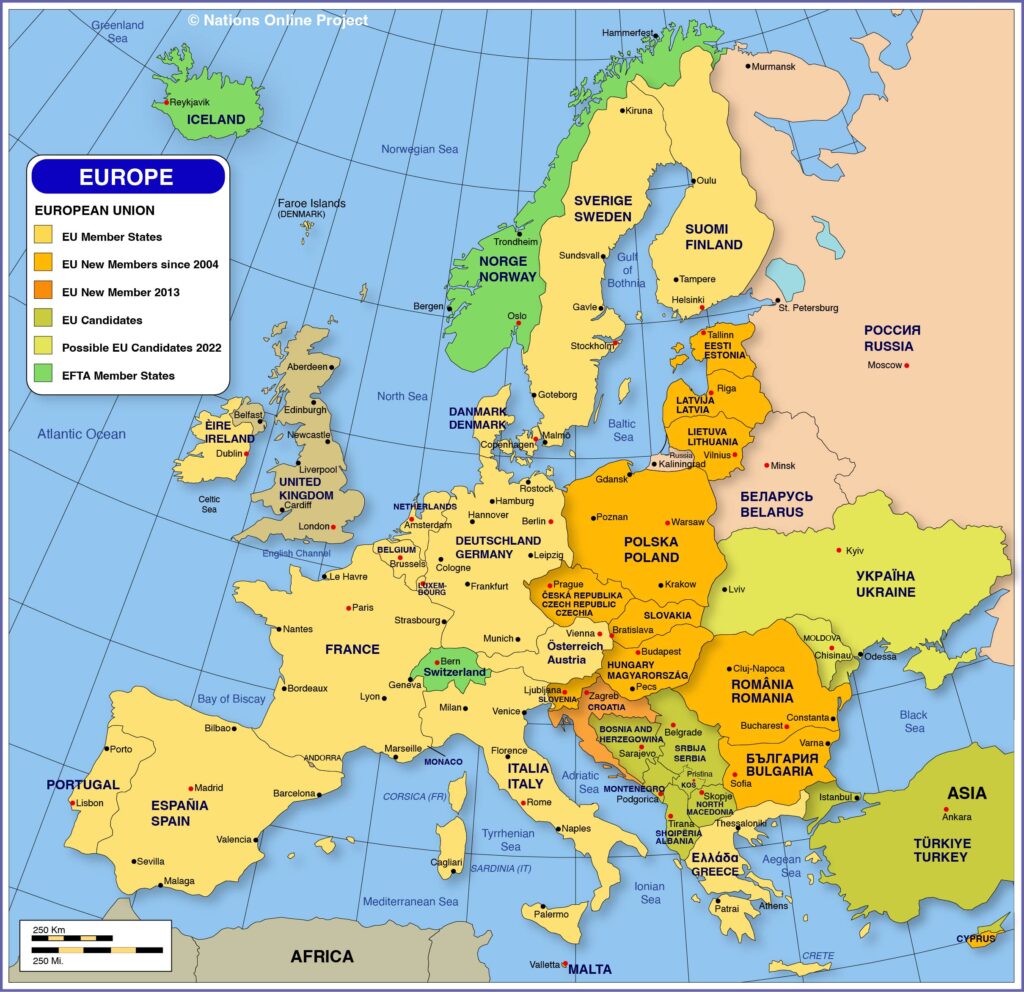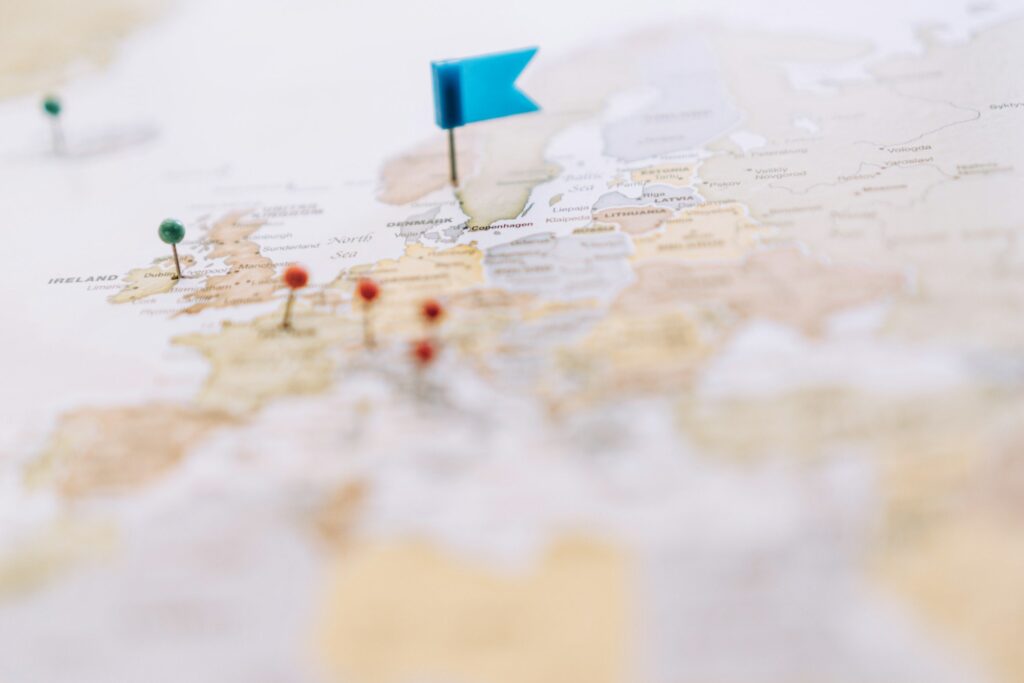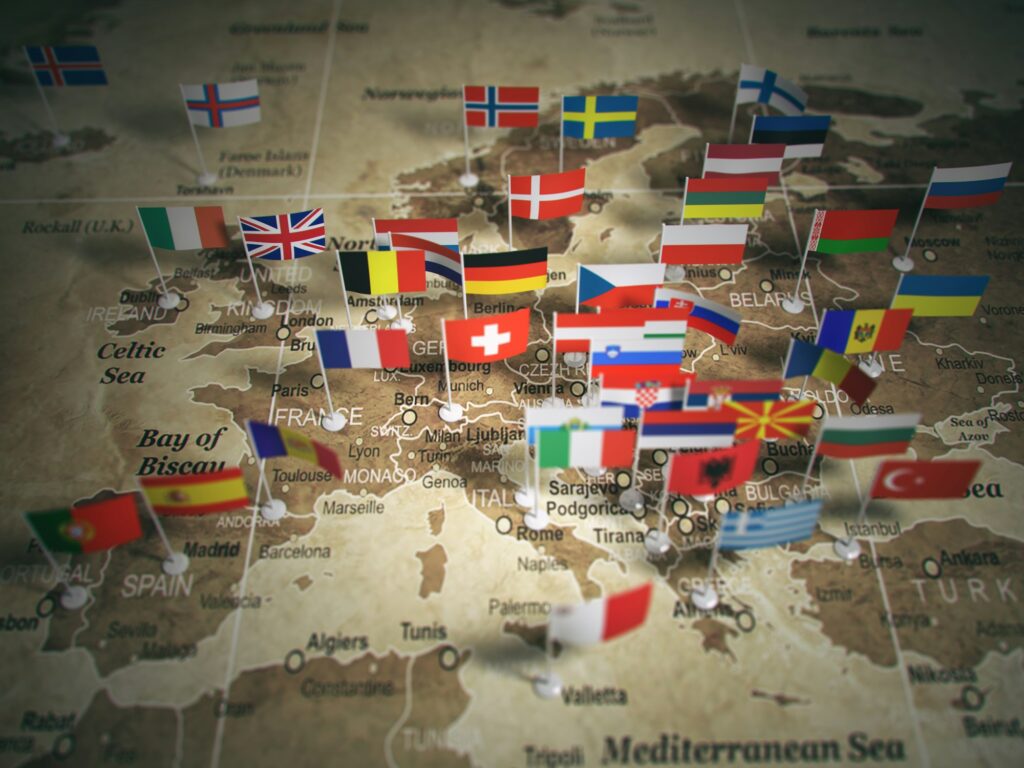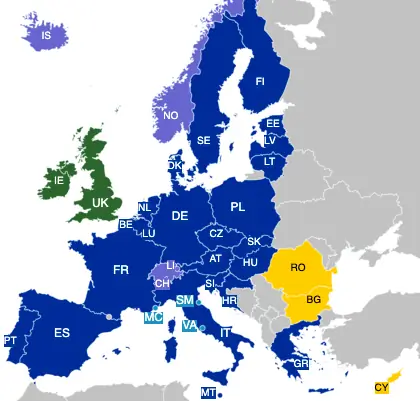Introduction to Europe Map for Travel Planning
Planning a trip to Europe? A detailed Europe map is your quintessential travel companion, transforming planning from daunting to delightful. This guide illuminates how a Europe map enriches travel planning, paired with tips for selecting the perfect map to suit your adventure.

Benefits of using a Europe map for travel planning
Using a Europe map offers several advantages when it comes to planning your travels:
Visualize Your Itinerary: A Europe map allows you to visualize your entire trip, enabling you to see the distances between different cities and countries. This helps in determining the most efficient routes and optimizing your time.
- Discover New Places: With a Europe map in hand, you can easily spot interesting towns, attractions, or landmarks that you might have missed otherwise. It helps you uncover hidden gems and plan detours to enhance your travel experience.
- Navigate with Ease: Getting around in a foreign country can be daunting, but a Europe map provides valuable navigation assistance. It allows you to plan your transportation routes, including trains, buses, or even road trips, ensuring you reach your desired destinations hassle-free.

How to choose the right Europe map for your needs
When choosing a Europe map for travel planning, consider the following factors:
- Size and Portability: Opt for a map that is convenient to carry and use while on the go. Consider foldable or pocket-sized options that won’t take up much space in your bag.
- Accuracy and Detail: Look for a map that provides accurate geographical information and includes key cities, major roads, and important landmarks. The more detailed the map, the easier it will be to plan your itinerary.
- Extras and Features: Some maps offer additional features such as highlighted tourist attractions, transportation routes, or even QR codes that provide more information. Consider these extras based on your specific travel needs.
Having a Europe map for travel planning can be a valuable tool in ensuring a smooth and enjoyable journey. It helps you visualize your itinerary, discover new places, and navigate with ease. So, before you embark on your European adventure, make sure to get the right map that caters to your travel needs.
Physical Europe Map

Hey there! If you’re planning a trip to Europe, having a good understanding of the physical features of the continent can be incredibly helpful. Let’s dive into an overview of the physical features of Europe and explore some travel destinations based on these geographical elements.
Overview of the physical features of Europe
Europe is a diverse and fascinating continent, offering a wide range of landscapes and natural attractions. From the towering peaks of the Alps to the enchanting coastlines along the Mediterranean Sea, Europe has something for everyone. Some key physical features of Europe include:
- Mountain ranges: Europe is home to several mountain ranges, including the Alps, Pyrenees, Carpathians, and Apennines. These mountain ranges offer breathtaking scenery and opportunities for outdoor activities like hiking, skiing, and mountaineering.
- Rivers: Europe boasts many iconic rivers, such as the Danube, Rhine, and Volga. These rivers have played a significant role in shaping European history and culture and offer picturesque landscapes and charming riverside cities to explore.
- Coastlines: Europe is surrounded by diverse coastlines from the rugged cliffs of Ireland’s Wild Atlantic Way to the sandy beaches of the French Riviera. Whether you’re looking for a beach holiday, a coastal hiking adventure, or a chance to discover charming fishing villages, Europe’s coastlines have it all.
Travel destinations based on geographical elements
Here are some travel destinations in Europe that you can explore based on specific geographical elements:
- Mountain lovers: If you’re a fan of breathtaking mountain landscapes, consider visiting the Swiss Alps in Switzerland, the French Alps in France, or the Dolomites in Italy. These destinations offer stunning views, excellent hiking trails, and idyllic alpine villages.
- River enthusiasts: For those who enjoy exploring riverside cities and cruising along scenic waterways, consider visiting Prague in the Czech Republic, Budapest in Hungary, or Amsterdam in the Netherlands. These cities offer rich history, charming architecture, and plenty of opportunities to take boat tours.
- Coastal adventurers: If you’re seeking coastal beauty, head to the Amalfi Coast in Italy, the Greek Isles, or the Algarve region in Portugal. These destinations offer gorgeous beaches, crystal-clear waters, and a blend of history, culture, and delicious cuisine.
Remember, Europe is home to countless incredible destinations, each with its own unique geographical appeal. So, whether you’re a mountain lover, a river enthusiast, or a coastal adventurer, Europe has something remarkable to offer. Happy travels!
Applications while your phone is charged
For map and navigation needs during your travels in Europe, these applications are highly recommended:
- Google Maps – A versatile option that allows for downloading maps for offline use, ensuring you can navigate without a data connection. It provides turn-by-turn voice directions and recalibrates your route if you take a wrong turn.
- Here WeGo – Another robust mapping solution that works offline, offering turn-by-turn voice directions. Ideal for travelers looking to conserve data while navigating Europe’s roads.
- Navmii – This app also provides free offline GPS navigation, with voice directions without requiring a data connection. It’s designed to re-route you correctly if you make a wrong turn, functioning much like a traditional GPS system but on your phone.
- Citymapper – Though not exclusively for offline use, Citymapper is valuable for navigating cities in Europe with its integration of public transit maps, real-time schedules, and updates. It’s available in nearly 20 European cities, offering detailed guidance for city navigation.
These apps can significantly ease the process of finding your way around Europe, whether you’re driving, taking public transport, or walking. Remember to download the necessary maps or data before you set out, especially if you plan to rely on offline features to avoid data charges.
Political Europe Map
Understanding the Political Divisions and Countries in Europe

As a traveler planning your trip to Europe, it’s essential to have a good understanding of the political divisions and countries in the region. Europe is divided into several countries, each with its own unique culture, history, and attractions. From popular destinations like France, Spain, and Italy to lesser-known gems like Slovenia and Lithuania, Europe offers a wide range of experiences.
The European map is characterized by a diverse mix of countries, including members of the European Union (EU) and non-EU countries. The EU is an economic and political union of 27 countries, with its headquarters in Brussels, Belgium. It aims to promote peace, prosperity, and cooperation among its member states. Some of the most well-known EU countries include Germany, the United Kingdom, and France.
Outside of the EU, there are also countries that are part of the European Free Trade Association (EFTA), such as Switzerland, Norway, Iceland, and Liechtenstein. These countries have close ties with the EU but are not EU members.
Major Cities and Capitals for Travel Exploration
Europe is home to some of the world’s most iconic and vibrant cities. From historic capitals to modern metropolises, there’s something for every traveler. Here are a few major cities and capitals that are worth exploring:
- London, United Kingdom: With its rich history, iconic landmarks like the Big Ben and Buckingham Palace, and vibrant cultural scene, London is a must-visit city for any traveler.
- Paris, France: Known as the “City of Love,” Paris is famous for its romantic atmosphere, world-class museums like the Louvre, and the iconic Eiffel Tower.
- Rome, Italy: As the capital of the Roman Empire, Rome is a treasure trove of ancient ruins, such as the Colosseum and the Roman Forum. It’s also home to the Vatican City, the smallest independent state in the world.
- Berlin, Germany: With its fascinating history, trendy neighborhoods, and vibrant nightlife, Berlin offers a unique blend of East and West cultures.
- Madrid, Spain: Known for its vibrant street life, magnificent art collections, and delicious cuisine, Madrid is a city that never fails to captivate visitors.
These are just a few examples, and there are countless other cities across Europe waiting to be explored. So grab a map, plan your itinerary, and get ready for an unforgettable journey through the diverse landscapes and cultures of Europe.
Top Tourist Attractions in Europe
When it comes to travel planning in Europe, there are countless must-visit tourist attractions that will leave you in awe. Here, I will take you through some of these incredible destinations based on location and highlight some of the most iconic landmarks that you should not miss.
Must-visit Tourist Attractions Based on Location
In Europe, each country has its own unique attractions that are worth exploring. Here are some must-visit destinations based on location:
- Paris, France: The Eiffel Tower and the Louvre Museum are iconic landmarks that should be on every traveler’s list.
- Rome, Italy: The Vatican City with St. Peter’s Basilica and the Colosseum are must-see attractions in the Eternal City.
- Barcelona, Spain: Visit the famous Sagrada Familia and explore the vibrant Gothic Quarter for an unforgettable experience.
- Amsterdam, Netherlands: Take a canal tour and visit the Anne Frank House and Van Gogh Museum in this charming city.
- Santorini, Greece: The breathtaking views of the caldera and the idyllic white-washed villages make Santorini a paradise for travelers.
Iconic Landmarks and Popular Destinations
Europe is home to some of the world’s most iconic landmarks and popular destinations. Here are a few that should not be missed:

- The Colosseum, Rome: This ancient Roman amphitheater is a symbol of the city’s rich history and a marvel of engineering.
- The Acropolis, Athens: Visit the Parthenon and other ancient Greek ruins perched high on a hill overlooking the city.
- The Louvre Museum, Paris: Explore the world’s largest art museum and witness famous masterpieces like the Mona Lisa.
- Neuschwanstein Castle, Germany: This fairytale-like castle nestled in the Bavarian Alps is a must-visit for its stunning architecture and breathtaking surroundings.
- The Tower of London, England: Explore this historic castle with its dark past and see the Crown Jewels on display.
Europe offers a wealth of attractions and landmarks that cater to all interests and preferences. Whether you are a history buff, an art lover, or a nature enthusiast, there is something for everyone in this diverse continent.
Europe Map for Itinerary Planning
Using a Europe map to plan your itinerary
When it comes to planning a trip to Europe, having a map is an invaluable tool. It allows you to visualize the different countries, cities, and attractions, helping you plan your itinerary more efficiently. With a map, you can identify the geographical proximity of destinations, which can help you decide on the best route to take and optimize your travel time. Whether you prefer to travel by train, car, or plane, a map provides a clear overview of the distances between locations, allowing you to plan your transportation logistics effectively.
Tips for maximizing your travel experience
Here are some tips to make the most out of your Europe travel experience using a map:
- Research and prioritize destinations: Study the map and identify the countries and cities that interest you the most. Prioritize the must-see destinations and plan your routes accordingly.
- Create a realistic itinerary: It can be tempting to try and cover as many cities as possible, but it’s important to be realistic about the time you have. Choose a few key destinations and allocate enough time to explore each one thoroughly.
- Consider transportation options: Look at the map to determine the best transportation options for your itinerary. Europe has an extensive network of trains, buses, and flights, and understanding the distances between destinations can help you choose the most convenient and efficient mode of transportation.
- Discover hidden gems: As you explore the map, don’t forget to look beyond the popular tourist destinations. Europe is full of hidden gems and off-the-beaten-path locations that can offer unique and authentic travel experiences.
By utilizing a Europe map for itinerary planning, you can make the most out of your trip, ensuring a smooth and enjoyable travel experience. So grab a map, start exploring, and get ready for an unforgettable adventure in Europe!
Europe Map for Transportation
When planning my travels in Europe, I find that utilizing a Europe map for transportation is incredibly helpful. It provides me with a visual overview of the continent’s major airports, train stations, and highways, enabling me to streamline my itinerary and make efficient travel arrangements.
Utilizing a Europe map for transportation planning
Using a Europe map for transportation planning allows me to easily identify the most convenient routes and modes of transportation to my desired destinations. I can assess the proximity of airports and train stations to my accommodations and plan my itinerary accordingly. This helps me save time and ensure a smooth travel experience.
Identifying major airports, train stations, and highways
With a Europe map, I can quickly locate major airports, train stations, and highways. This information is crucial for planning my travel routes, determining the most convenient entry points into different countries, and identifying suitable transportation options. It allows me to optimize my travel plans and make informed decisions.
Whether I’m embarking on a backpacking adventure or exploring specific regions within Europe, having a Europe map for transportation planning provides me with the necessary information to create a well-organized travel itinerary. It ensures that I can efficiently navigate through the continent and make the most of my time exploring its diverse offerings.
Europe Map for Accommodation
When planning a trip to Europe, having a Europe map can be a valuable tool for finding accommodation options. It allows you to visualize the different locations and easily identify the best areas for hotels and rentals.
Finding accommodation options using a Europe map
Using a Europe map, you can easily search for accommodation options in different cities and regions. Whether you prefer a hotel or a vacation rental, the map provides a visual representation of the available options. This allows you to compare prices, locations, and amenities, making it easier to find the perfect place to stay during your trip.
Identifying the best locations for hotels and rentals
The Europe map also helps in identifying the best locations for hotels and rentals. It allows you to see the proximity of accommodations to popular attractions, landmarks, and transportation hubs. This way, you can choose a location that suits your preferences and makes it convenient for exploring the surrounding areas.
Whether you are planning a backpacking adventure across Europe or a romantic getaway in a specific city, using a Europe map for accommodation can significantly enhance your travel planning experience. It gives you a better understanding of the available options and allows you to make informed decisions based on your preferences and needs.
Conclusion
In conclusion, a Europe map is an essential tool for travel planning. It offers numerous benefits such as visualizing your itinerary, understanding distances between destinations, and discovering new places to explore. By using a map, you can efficiently plan your routes, optimize your travel time, and make the most of your European adventure.
Summary of the benefits and importance of a Europe map for travel planning
- Visualize your itinerary: A map allows you to see the geographical layout of Europe and visualize your travel route. This helps you plan your journey more effectively.
- Understand distances: By using a map, you can get a sense of the distances between destinations. This knowledge allows you to plan your travel time and schedule your activities accordingly.
- Discover new places: A map can help you discover hidden gems and lesser-known destinations that you may have otherwise missed. It provides a comprehensive overview of Europe, allowing you to explore off the beaten path.

